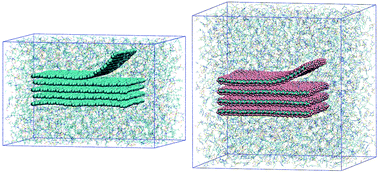当前位置:
X-MOL 学术
›
Faraday Discuss.
›
论文详情
Our official English website, www.x-mol.net, welcomes your
feedback! (Note: you will need to create a separate account there.)
Exfoliation of graphene and fluorographene in molecular and ionic liquids
Faraday Discussions ( IF 3.3 ) Pub Date : 2017-06-13 00:00:00 , DOI: 10.1039/c7fd00169j Émilie Bordes 1, 2, 3, 4, 5 , Joanna Szala-Bilnik 1, 2, 3, 4, 5 , Agílio A. H. Pádua 1, 2, 3, 4, 5
Faraday Discussions ( IF 3.3 ) Pub Date : 2017-06-13 00:00:00 , DOI: 10.1039/c7fd00169j Émilie Bordes 1, 2, 3, 4, 5 , Joanna Szala-Bilnik 1, 2, 3, 4, 5 , Agílio A. H. Pádua 1, 2, 3, 4, 5
Affiliation

|
We use molecular dynamics simulations to study the exfoliation of graphene and fluorographene in molecular and ionic liquids, by performing computer experiments in which one layer of the 2D nanomaterial is peeled from a stack, in vacuum and in the presence of solvent. The liquid media and the nanomaterials are represented by fully flexible, atomistic force fields. From these simulations we calculate the potential of mean force, or reversible work, required to exfoliate the materials. Calculations in water and organic liquids showed that small amides (NMP, DMF) are among the best solvents for exfoliation, in agreement with the experiment. We tested ionic liquids with different cation and anion structures, allowing us to learn about their solvent qualities for the exfoliation of the nanomaterials. First, a long alkyl side chain on the cation is favourable for exfoliation of both graphene and fluorographene. The presence of aromatic groups on the cation is also favourable for graphene. No beneficial effect was found between fluorine-containing anions and fluorographene. We also analysed the ordering of ions in the interfacial layers with the materials. Near graphene, nonpolar groups are found along with charged groups, whereas near fluorographene almost exclusively non-charged groups are found, with ionic moieties segregated to the second layer. Therefore, fluorographene appears to be the more hydrophobic surface, as expected.
中文翻译:

石墨烯和氟石墨烯在分子和离子液体中的剥落
通过执行计算机实验,其中在真空中和存在溶剂的情况下,将2D纳米材料的一层从堆栈中剥离,我们使用分子动力学模拟研究了分子液体和离子液体中石墨烯和氟石墨烯的剥落。液体介质和纳米材料以完全柔性的原子力场为代表。从这些模拟中,我们计算出剥落材料所需的平均力或可逆功的潜力。在水和有机液体中的计算表明,与实验一致,小分子酰胺(NMP,DMF)是最好的去角质溶剂。我们测试了具有不同阳离子和阴离子结构的离子液体,从而使我们能够了解其剥离纳米材料的溶剂质量。第一的,阳离子上的长烷基侧链有利于石墨烯和氟代石墨烯的剥落。阳离子上芳族基团的存在对石墨烯也是有利的。在含氟阴离子和氟石墨烯之间未发现有益效果。我们还分析了界面层中与材料相关的离子的顺序。在石墨烯附近,发现非极性基团与带电基团,而在氟石墨烯附近,几乎仅发现不带电基团,且离子部分隔离到第二层。因此,如预期的那样,氟石墨烯似乎是更疏水的表面。我们还分析了界面层中与材料相关的离子的顺序。在石墨烯附近,发现非极性基团与带电基团,而在氟石墨烯附近,几乎仅发现不带电基团,且离子部分隔离到第二层。因此,如预期的那样,氟石墨烯似乎是更疏水的表面。我们还分析了界面层中与材料相关的离子的顺序。在石墨烯附近,发现非极性基团与带电基团,而在氟石墨烯附近,几乎仅发现不带电基团,且离子部分隔离到第二层。因此,如预期的那样,氟石墨烯似乎是更疏水的表面。
更新日期:2017-12-15
中文翻译:

石墨烯和氟石墨烯在分子和离子液体中的剥落
通过执行计算机实验,其中在真空中和存在溶剂的情况下,将2D纳米材料的一层从堆栈中剥离,我们使用分子动力学模拟研究了分子液体和离子液体中石墨烯和氟石墨烯的剥落。液体介质和纳米材料以完全柔性的原子力场为代表。从这些模拟中,我们计算出剥落材料所需的平均力或可逆功的潜力。在水和有机液体中的计算表明,与实验一致,小分子酰胺(NMP,DMF)是最好的去角质溶剂。我们测试了具有不同阳离子和阴离子结构的离子液体,从而使我们能够了解其剥离纳米材料的溶剂质量。第一的,阳离子上的长烷基侧链有利于石墨烯和氟代石墨烯的剥落。阳离子上芳族基团的存在对石墨烯也是有利的。在含氟阴离子和氟石墨烯之间未发现有益效果。我们还分析了界面层中与材料相关的离子的顺序。在石墨烯附近,发现非极性基团与带电基团,而在氟石墨烯附近,几乎仅发现不带电基团,且离子部分隔离到第二层。因此,如预期的那样,氟石墨烯似乎是更疏水的表面。我们还分析了界面层中与材料相关的离子的顺序。在石墨烯附近,发现非极性基团与带电基团,而在氟石墨烯附近,几乎仅发现不带电基团,且离子部分隔离到第二层。因此,如预期的那样,氟石墨烯似乎是更疏水的表面。我们还分析了界面层中与材料相关的离子的顺序。在石墨烯附近,发现非极性基团与带电基团,而在氟石墨烯附近,几乎仅发现不带电基团,且离子部分隔离到第二层。因此,如预期的那样,氟石墨烯似乎是更疏水的表面。











































 京公网安备 11010802027423号
京公网安备 11010802027423号